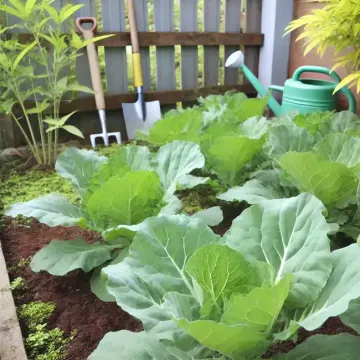Collard greens (Brassica oleracea, Acephala Group) are a leafy green vegetable known for their large, dark green leaves and rich, slightly bitter flavor. They are a staple in Southern cuisine and have been enjoyed for centuries due to their nutritional value and adaptability in various dishes. Growing collard greens in the home garden is a rewarding experience for both novice and experienced gardeners alike. This cold-hardy plant is relatively easy to grow and can provide an abundant harvest throughout the growing season.
History of Collard Greens
Collard greens have a long history dating back to ancient times. Originally cultivated by the ancient Greeks and Romans, collards made their way to the Americas through European settlers and African slaves. In the Southern United States, collard greens became a key ingredient in African American cuisine, often served as a side dish with cornbread and other staples. Over time, collard greens have become a symbol of Southern culture and are enjoyed nationwide.
Health Benefits
Collard greens are a nutritional powerhouse, packed with vitamins and minerals. They are an excellent source of vitamins A, C, and K, as well as folate and calcium. Additionally, collard greens are rich in antioxidants and fiber, making them beneficial for heart health, digestion, and overall well-being. Their high vitamin K content is particularly beneficial for bone health and blood clotting. Including collard greens in your diet can help support a healthy immune system and reduce the risk of chronic diseases.
Culinary Uses
Collard greens are versatile in the kitchen and can be prepared in a variety of ways. They are often simmered or braised with meats, such as ham hocks or bacon, to create a flavorful side dish. In addition to traditional Southern recipes, collard greens can be used in soups, stews, and salads. Their sturdy leaves also make them an excellent alternative to tortillas or wraps in low-carb dishes. Blanching the leaves before using them in wraps can soften them and make them easier to work with.
Growing Tips
1. Planting:
- Soil: Collard greens thrive in well-drained, fertile soil with a pH between 6.0 and 7.0. Adding compost or well-rotted manure before planting can help improve soil structure and nutrient content.
- Sunlight: These greens prefer full sun but can tolerate partial shade, especially in hotter climates.
- Spacing: Plant seeds or transplants about 18 to 24 inches apart in rows spaced 36 inches apart. This spacing allows for good air circulation, which helps prevent disease.
- Timing: Collard greens can be planted in both the spring and fall. In cooler climates, start seeds indoors 4 to 6 weeks before the last frost date and transplant them into the garden once the soil warms up. In warmer regions, direct sow seeds in the garden in early spring or late summer for a fall crop.
2. Watering: Collard greens need consistent moisture to produce tender, flavorful leaves. Water regularly, aiming for about 1 to 1.5 inches of water per week. Mulching around the plants can help retain soil moisture and keep the roots cool, which is especially important in hot weather.
3. Fertilization: Collard greens are heavy feeders and benefit from regular fertilization. Apply a balanced fertilizer (such as 10-10-10) every 4 to 6 weeks during the growing season. Alternatively, side-dress with compost or a nitrogen-rich fertilizer to promote lush leaf growth.
4. Pests and Diseases: Common pests that affect collard greens include aphids, cabbage worms, and flea beetles. Use row covers to protect young plants from pests and apply organic insecticidal soap if infestations occur. Collard greens can also be susceptible to diseases like downy mildew and black rot. Rotate crops and practice good garden hygiene to minimize disease risk.
5. Harvesting: Collard greens can be harvested as needed throughout the growing season. Start by picking the outer leaves when they are large enough to use, usually about 10 inches long. Be sure to leave the central bud intact so the plant can continue producing new leaves. Collard greens can tolerate light frosts, and the leaves may even become sweeter after a frost. However, be sure to harvest them before a hard freeze.
Conclusion
Growing collard greens in your home garden is a great way to enjoy fresh, nutritious greens throughout the year. Their resilience to cooler temperatures, combined with their rich flavor and versatility in the kitchen, make them an excellent addition to any vegetable garden. With proper care, you can enjoy bountiful harvests of collard greens to use in a variety of delicious dishes. Whether you’re an experienced gardener or just starting out, collard greens are a rewarding and nutritious crop to grow at home.

